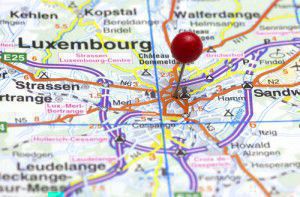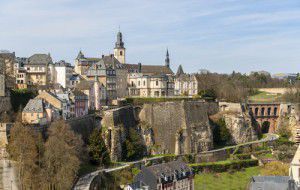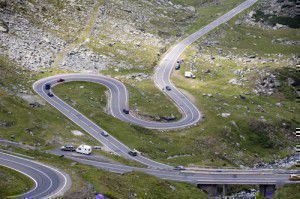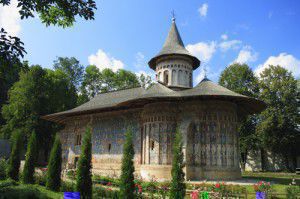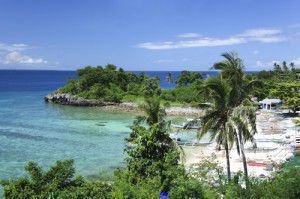10 reasons to visit… Luxembourg
Having just returned from a short trip to Luxembourg, I thought I’d continue with our ’10 reasons to visit’ series by giving you a few reasons why you should consider a trip to this central European country.
Luxembourg may be small, but it’s certainly worth a visit, and here’s why:
1. Great links with the rest of Europe
Luxembourg is just a short, hour-long flight from London, with several airlines and airports serving Lux airport. Our return flights were only £60 with BA. Or you could easily fly or drive from most big cities in Europe. Luxembourg also uses the Euro, which is convenient for other European visitors.
2. It’s quick and easy to visit France/Germany/Belgium
Ok… so my second reason to visit a place probably shouldn’t be that it’s easy to leave it again, but hear me out! I spent five days with a friend who lives in Luxembourg city, and during that time we hopped on the train over to the border to Trier in Germany and Nancy in France for just 10 euros a time. Luxembourg’s central location and small size means it’s easy to get two or three countries for your money by taking a short drive or train ride to one of the nearby cities, and fit as much as possible into your trip.
3. Linguistic diversity
Of course, my next reason has to be language-related! This small country has THREE official languages: Luxembourgish, which is spoken as a mother tongue by almost all residents; French, which is commonly used in restaurants, shops and cafes, and German which is frequently heard in the media. English is also widely spoken. So while you’re there, you can easily practise your French or German, as well as maybe picking up a few phrases of the local language. It was definitely a good opportunity for me to use a bit of French when ordering food and drinks. (By the way, EuroTalk offer all three official languages.)
4. Food and drink
Luxembourgish cuisine is very similar to German/Austrian, with plenty of meat and potato-based dishes. I came across plenty of my favourite German dishes such as Kaesspaetzle (an egg based dish which is a little like pasta or dumplings, with plenty of cheese!), Schnitzel (breaded pork fillets) and Rosti (Swiss-style potato cakes), not to mention Apfelstrudel and cheap beer. But if heavier dishes are not to your taste, there are plenty of French and Italian influenced restaurants in the city as well.
5. Amazing architecture
Luxembourg City used to be a fortress city which was completely surrounded by high stone walls. Those walls are still there, and you can climb to the top and walk around them for an incredible view of the city. The architecture is also beautiful, with many typical cone-shaped roofs and an architectural style that mixes French and German traditions. Planning and building laws in Luxembourg are also much looser than in many other European countries, meaning almost all the houses are built in different styles and colours.
6. Museums and culture
We visited the Luxembourg City History Museum, which is only 3 euro entry, but worth every cent. The museum covers every aspect of Luxembourgish life, from exhibits on the city’s architecture, with models of the city during different periods of its existence, to an entire floor dedicated to shopping and consumer culture, a basement level which is cut into the rock that the city is built on, and loads of fascinating information about the city’s occupation by the Nazis during the WW2 era. It also has great views over the city, especially from the glass lift. The museum is a proper maze and you can get lost in there for hours and find out about all sorts of aspects of Luxembourg City.
7. Landscape and cityscape
Interestingly, the city is built around a huge canyon (for want of a better word!). You must therefore either take one of the city’s many bridges to get to the other side, or you can walk down into the canyon and explore the park, which has a small river and beautiful views. Many people go running or cycling down there, and it’s a great place to chill out or take a walk.
8. Nature is close at hand
The city is full of green spaces, including parks and the river, and you’re never more than short walk from a green area to chill out and relax. However, a short trip outside the city and you’ll be in the midst of the country’s miles and miles of relatively unspoiled countryside. Luxembourg is great for cycling, hiking and fishing or boating. There are also 400 square kilometres of nature parks, many lakes and rivers and miles of cycle routes and hiking trails. As a bonus, the city is also very bike-friendly. You can rent a bike from the Veloh scheme, and there are bike lanes everywhere so you can cycle safely.
9. Shopping!
Unfortunately, Luxembourg isn’t the cheapest place to go on holiday. Wages there are high and the city’s livelihood is largely based on banking. As a result, food prices, for example, are relatively high. However, Luxembourg City and some of the surrounding cities are great places to shop, especially if you’re interested in high-end boutiques and designer labels. If you’re looking for flea markets or bargain hunting then it’s probably not the place for you, but there are several quaint little artisan chocolate, cheese and wine shops, as well as a wide range of designer stores which are worth a look, even if you’re only window shopping.
10. Visit the only remaining grand duchy
Luxembourg is not only one of the smallest sovereign nations in Europe, it’s also the world’s only remaining grand duchy, meaning it’s headed by a grand duke rather than a king/queen or president. You can see the grand duke’s palace in the centre of the city, and his son was recently married in a huge public ceremony which was watched by most of the nation. You can also see the country’s main legislative building, the Chamber of Deputies, right in the city centre.
Alex
10 reasons to visit… Romania
As you know, we love travelling and learning about all kinds of cultures around the world, so we decided to start the ’10 reasons’ series – every now and then we’re going to give you 10 reasons for which you should consider visiting a new country.
This month I chose Romania because it is my home country and because I can think of a lot more than ten reasons to visit this beautiful country. So, enjoy your read and please note that the reasons are not stated in any particular order – all are equally important.
1. Breathtaking mountain landscapes
Romania is one of the ‘lucky’ countries which gets to enjoy both mountains and sea, but the truly amazing landscapes are definitely to be seen in the Carpathian mountains. There are two main roads that traverse the mountain chain and they are Transalpina and Transfagarasan. These roads reach the altitude of 2042 metres (6700 ft) and take you through endless curves and sheer drops – make sure you pull over to take photos.
2. Transylvania
This might be the best known area in Romania, mainly because of the Dracula myth that is supposed to have taken place here. I’m not going to tell you about how you can have vampire encounters (Dracula is as real as Edward Cullen so don’t get your hopes up), instead I’m going to tell you that this is a very special part of Romania, having many colourful medieval cities with beautiful architecture as well as friendly people and delicious food – but more about this in the following points.
3. Black Sea resorts and summer fun
My hometown is on the Black Sea shore and I can promise you, it is like Ibiza down there. There are parties almost every day of the week during the summer but the weekend is when it gets really loud and fun. Most Romanians go there for a couple of weekends during the summer for festivals and other party-related events. You can even go on your own, you will make a lot of friends. During the day, you can lay on the beach and get a nice tan to show off when you go back.
4. Finger-licking food
If you decide to take a trip to Romania, make sure you are ready to come back home with 5-10 pounds extra, as the food over there is delicious – from the national food cabbage rolls (or stuffed cabbage) with porridge made out of yellow maize flour, to any kind of pies and cocoa sponge cake to Turkish influenced cuisine, everything you will eat there will taste amazing! On top of that, most Romanian women are really good cooks.
5. Ski- and winter-resorts
Now, I’m not much of a skier but I can tell you that you can have a great time skiing or snowboarding in the winter in the Romanian mountain resorts. The best known area for this is Prahova Valley, which is basically a river making its way thorough the chain of mountains and there are about 7-8 small resorts where you can get your share of winter fun, winter landscapes and mulled wine (what, did you think there’s no alcohol involved?).
6. The Danube Delta
If you’re more the nature-loving/sleeping-in-a-tent-is-fun kind of person you might want to take a trip here. This place is a naturally formed delta, where the Danube flows into the Black Sea. It is known for its wild places because it is pretty difficult to live there all year round given all the water and muddy islands. There are some men-built resorts where you can stay if you don’t enjoy the wilderness that much but the true sense of this place is that you can have that bonding-with-nature kind of experience.
7. The beautiful girls
Don’t get me wrong, this is not a ‘place’ you can visit, they don’t have them all lined up behind a window (although, you can find that in Amsterdam – so I’ve heard). It’s just that Romanian women are known to be beautiful and that is mostly because they take much interest in their appearance and they enjoy going out in cafés, pubs or clubs – so that makes them something you might want to experience seeing in Romania.
8. Bucharest nightlife
Speaking of clubs, this brings me to the capital of Romania – Bucharest. This big city has a vivid nightlife and fancy, luxurious clubs with music that plays till the sunrise. The custom is that you go to a club where you party & drink til 5-6 a.m. and then you go and have some Turkish kebab or shaworma (a kind of wrap) as a hangover cure. The place where you can find most of the clubs is the Old City Centre, which is very beautiful to visit during the day as well.
9. Northern Moldavia
If you are more the museum-visiting type, this area is one that you would enjoy. There are a lot of old monasteries (some date from the 14th-16th century) where nuns and monks still live nowadays and that are part of the UNESCO world heritage because they are represent the Romanian tradition. They are usually surrounded with vegetation so that can be a place to find peace and serenity even if you are not religious. Be careful of the dress code – you have to wear trousers (or a long skirt) and something rather decent for the top part.
10. The people
I’ve saved the best for last. One important reason you should visit Romania is to find that the people there are welcoming and warm, that you can make long lasting friendships very quickly and that even though Romania is a country that has had many struggles in the past, people are still good at heart and they will welcome you in their house as a friend, not a tourist.
And of course before you go, don’t forget to learn some Romanian, and take uTalk with you in case you get stuck while you’re there…
If you have any suggestions for our next ’10 reasons to visit…’ post, please let us know!
Ioana
15 cultural faux pas to avoid when travelling
Before you go on holiday, or on a business trip abroad, it’s a great idea to learn a little of the local language. But getting along with people is about much more than just the words you say. There are other rules too, so here are our top tips to avoid misunderstandings abroad.
1. Be very careful when exchanging business cards in Japan: they aren’t just cards, but representations of the giver and should be handled with some ceremony. NEVER write on a business card or put it in your back pocket, as this is considered disrespectful.
2. Don’t talk about work over dinner in New Zealand, even if you’re having a meal with your colleagues. It’s fine to talk business over lunch, though.
3. In Muslim countries it’s considered an insult if you show the soles of your feet, so watch how you sit.
4. If you’re in Hungary and you’ve been told your meeting is at ‘fél négy’ (‘half four’), don’t turn up at 4:30 – ‘fél négy’ actually means half an hour TO four, so you’ll need to be there at half past three.
5. On the other hand, if you’ve been invited to a gathering in France, always aim to arrive 15-30 minutes late, to allow the host time to get ready.
6. Making a circle with your forefinger and thumb as another way of saying ‘OK’ is seen as an extremely offensive gesture in Brazil. As is the ‘thumbs up’ gesture in Iran, and showing your palm in Greece. It might be better to just avoid hand gestures altogether…
7. In Germany, not making eye contact when you clink glasses is considered very rude. It also, apparently, means you’ll have seven years’ bad luck in the bedroom. So even if you’re not worried about being thought bad-mannered, it might be worth making the effort. Just in case.
8. In Bulgaria, nodding your head means no, and shaking your head means yes, which is the opposite of what most of us are used to. This is worth remembering or you could get yourself into all kinds of trouble.
9. It’s been illegal to bring chewing gum into Singapore since 2004, because of the damage being caused to public buildings and facilities by people leaving their gum behind. You can also be fined for not flushing a public toilet.
10. In Russia, if you’re giving someone flowers, make sure you give them an odd number. Even numbers are for funerals.
11. It’s important to show respect to your elders in Asia, so don’t call them by their name; instead use ‘Auntie’ or ‘Uncle’, even if you don’t know them.
12. When eating a meal in Spain, you’ll be expected to clear your plate, and leaving some food is seen as rude. In Russia, on the other hand, you’re expected to leave a little as a sign that your host has provided enough to fill you up. And in China, a polite belch when you finish eating is considered a compliment to the chef, although it’s frowned upon in many other countries.
13. Never say anything disrespectful about the king in Thailand, as this could land you in prison for several years.
14. Make sure you’re appropriately dressed before going to church in Italy. This means your shoulders, knees and midriff should all be covered, or you won’t be allowed in.
15. In Malawi, it’s common for people of the same sex to hold hands; this is a sign of close friendship, so don’t worry if someone tries to take your hand. It’s a compliment. Men and women holding hands is rare, though, and may be frowned upon.
As always, if anyone has any others, we’d love to hear from you!
10 of the world’s most amazing places
One of our top tips for learning a language is to take a holiday – it not only gives you a chance to practise your new language with the locals but you also get to visit somewhere nice. And why not take the opportunity to visit some of the world’s most amazing (if sometimes slightly bizarre) places while you’re at it?
1. San Alfonso del Mar
Like the world’s largest swimming pool, for instance, which is at San Alfonso del Mar in Chile. If you’re thinking of swimming lengths, you might want to stock up on energy drinks before diving in to this one. It’s more than 1,013 metres long, so paddlers should beware! It also has a 35-metre deep end – not for the unwary swimmer. The Guinness Book of Records named this pool as the biggest in the world, needing 66 million gallons of water to fill it up.
2. Mt HuaShan
Or maybe you’d like to visit a traditional Chinese tea house. What about this one, at the top of Mt. HuaShan? It’s 2,160 metres high and the path to get there is nothing short of terrifying. It’s thought that there may be as many as 100 fatal falls a year, and yet the trail is popular with tourists, keen to visit the teahouse, on the southern summit of the mountain, which used to be a Taoist temple, or the chess pavilion on the east peak.
3. Stewart Island
If bird-watching is your thing, you could visit Stewart Island in New Zealand. It’s one of the most remote destinations in the world, with only one town, Halfmoon Bay (also known as Oban) and an estimated population of just 450 people. The island is the only place to see the Kiwi bird in its natural habitat and is also home to five species of penguin.
4. Pink Lake
Next door in Australia, Pink Lake, just west of Esperance, is worth a visit. As its name would suggest, in certain weather conditions the water in the lake is pink, thanks to a particular kind of algae in the water. And this isn’t the only pink lake in the area. Lake Hillier, on Middle Island, is another example and an even brighter colour.
5. Joffre Lakes
However, if you prefer your lakes blue, the Canadian park of Joffre Lakes in British Columbia comes highly recommended. The lakes are a more traditional, but stunningly beautiful, turquoise blue and surrounded by peaks and glaciers. A trip to Joffre Lakes isn’t complete without an overnight stay, where you can camp under the stars and listen to the ice calving from the glacier.
6. Kizhi
The Russian island of Kizhi is found almost exactly at the centre of Lake Onega and boasts a spectacular wooden church, the Church of the Transfiguration, which was built in the 18th century without a single nail. Legend says that the lead builder used just one axe for the whole building, and then threw it in the lake when the church was completed, saying, ‘There was not and will not be another one to match it.’
7. Kayaköy
Just a few miles from the popular resort of Fethiye in southwestern Turkey, on the side of a mountain, is the village of Kayaköy. Greek-speaking Christians lived there until the 1920s but the village was abandoned follow a population exchange agreement between Turkey and Greece in 1923. Now a museum and historical monument, Kayaköy is a beautiful but rather eerie ghost town.
8. Capuchin monastery
Speaking of eerie, the Capuchin monastery in Sicily is home to 8,000 mummified corpses in the monastery catacombs. The bodies are all dressed in their best clothes and arranged in different rooms according to the type of person. The oldest in the collection dates from 1599, while the most recent addition is the body of Rosalia Lomabardo, who was embalmed in 1920 and is known as ‘Sleeping Beauty’.
9. ICEHOTEL
If you’re looking for somewhere a bit different to stay, you could try the ICEHOTEL in Jukkasjärvi, Sweden. Made with ice from the Torne River, the hotel offers ice and snow rooms, and runs a survival course every night for new guests on what to wear and how to cope when sleeping in temperatures below zero. But don’t worry – warm rooms are also available if you’re not a fan of the cold.
10. Malapascua
One extreme to the other – the island of Malapascua in the Phillippines boasts beautiful beaches and is most popular with divers, as it’s the only place in the world to see the pelagic thresher shark. There’s no transport on the island because it’s small enough to walk everywhere, and the only way to arrive on the island is by banca (a local boat ferry).
We hope that’s given you a few ideas for your next holiday. Don’t forget to learn a few words in the local language before you leave! And if we missed your favourite place, let us know in the comments…
Could you repeat that, please?
Today’s guest post is from Sian, a British ex-pat living in Turkey, who has some advice for anyone considering moving abroad.
Merhaba. Last year I made a life changing decision and decided that, at the age of 42, I wanted to leave the UK and move to Turkey. After much research, a lot of visits to the vets to ensure my two elderly cats could come, and a lot of packing and sorting out, the day finally came and on April 15th this year I moved lock, stock and barrel to Fethiye (you can follow my story on my blog, To Fethiye and Beyond).
Have I regretted it? Absolutely not. Would I advise other people to give it a try? Oh yes. Is it hot? Like you wouldn’t believe. Would I suggest that they learn some of the language before they came? Definitely. Unfortunately I didn’t follow my own advice and barely learnt more than 3 or 4 words before coming out here. Luckily for me, I armed myself with a EuroTalk Turkish DVD before I left so, yes, I do know a lot more Turkish now than when I arrived – although I still sometimes struggle with the simplest of words, the main one being teşekkürler, which means thanks – for some reason I keep thinking of it as ‘testicular’ which is not going to win me any friends (well, not the right sort anyway!).
Not only is the Turkish language very hard, what with its ‘i’ with a dot that is pronounced like ‘ee’, its ‘l’ without a dot (that isn’t an L) that is pronounced like a ‘u’, its ‘c’ that is pronounced like a ‘j’, while the ‘j’ is pronounced like an ‘s’ (seriously, who thought up this language!)… but the local people here also love to practise their English. You may start with every intention of saying something in the local language but as soon as they spot you they say hello, how are you and your brain just goes to mush and you respond in English.
Mind you, something must be sinking in as I did actually manage to have a conversation in Turkish just the other day. Admittedly it wasn’t the longest of conversations but we’ve all got to start somewhere, haven’t we?

I absolutely refuse to be a parody of a Brit abroad and spend the rest of my life speaking v-e-r-y s-l-o-w-l-y in English to the locals in a slightly patronising manner so I am going to keep on going with the EuroTalk DVD and hopefully by the end of the year I’ll be able to manage an even longer conversation!
And on that note I’ll say görüşürüz and wish you all a pleasant day.
Are you moving abroad? Let us know! We’d love to help you start learning the basics of your new country’s language.
